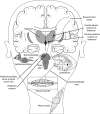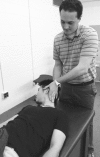Cervical Injury Assessments for Concussion Evaluation: A Review
- PMID: 27835042
- PMCID: PMC5264559
- DOI: 10.4085/1062-6050-51.12.15
Cervical Injury Assessments for Concussion Evaluation: A Review
Abstract
Background: A concussion is a complex pathophysiologic process that is induced by biomechanical forces and affects the brain. Cervical injuries and concussion can share similar mechanisms and nearly identical symptoms or causes. Therefore, symptoms or causes alone may be insufficient to differentiate between patients with a concussion and patients with cervical injuries.
Objective: To demonstrate the homogeneous causes and symptoms observed in patients with a concussion and patients with cervical injury and to provide information on clinical tests that can differentiate cervical injury from pathologic conditions of vestibular or central origin.
Summary: Given that concussion and cervical injury share similar causes and symptoms, this information alone may be insufficient to diagnose a concussion. Clinical assessments, such as the cervical joint-reposition error test, smooth-pursuit neck-torsion test, head-neck differentiation test, cervical flexion-rotation test, and physical examination of the cervical spine, can be performed after a head and neck pathomechanical event to identify the presence of cervical injury. Differentiating between a concussion and cervical injury is clinically vital for timely and appropriate evidence-based treatment.
Conclusions: Specific clinical tests should be used after a head and neck pathomechanical event to differentiate between symptoms due to a concussion and cervical injury. Continued research on the clinical utility of the 5 identified cervicogenic tests is also recommended.
Keywords: cervical flexion-rotation test; cervical joint-reposition error; cervicogenic pain; head-neck differentiation test; smooth-pursuit neck-torsion test.
Figures




Similar articles
-
Can the Neck Contribute to Persistent Symptoms Post Concussion? A Prospective Descriptive Case Series.J Orthop Sports Phys Ther. 2019 Nov;49(11):845-854. doi: 10.2519/jospt.2019.8547. Epub 2019 Jun 1. J Orthop Sports Phys Ther. 2019. PMID: 31154952
-
Brain or strain? Symptoms alone do not distinguish physiologic concussion from cervical/vestibular injury.Clin J Sport Med. 2015 May;25(3):237-42. doi: 10.1097/JSM.0000000000000128. Clin J Sport Med. 2015. PMID: 25051194
-
Normative Responses to Clinical Tests for Cervicogenic Dizziness: Clinical Cervical Torsion Test and Head-Neck Differentiation Test.Phys Ther. 2020 Jan 23;100(1):192-200. doi: 10.1093/ptj/pzz143. Phys Ther. 2020. PMID: 31584656
-
A Practical Concussion Physical Examination Toolbox.Sports Health. 2016 May/Jun;8(3):260-269. doi: 10.1177/1941738116641394. Sports Health. 2016. PMID: 27022058 Free PMC article. Review.
-
A scoping review of cervical spine evaluation in standardised clinical concussion evaluation tools.Phys Ther Sport. 2022 Sep;57:95-104. doi: 10.1016/j.ptsp.2022.07.010. Epub 2022 Aug 2. Phys Ther Sport. 2022. PMID: 35963133 Review.
Cited by
-
Chiropractic Management of Neck Pain Complicated by Symptomatic Vertebral Artery Stenosis and Dizziness.Am J Case Rep. 2022 Oct 19;23:e937991. doi: 10.12659/AJCR.937991. Am J Case Rep. 2022. PMID: 36258651 Free PMC article.
-
The role of the physiotherapist in concussion.S Afr J Physiother. 2024 Apr 30;80(1):2013. doi: 10.4102/sajp.v80i1.2013. eCollection 2024. S Afr J Physiother. 2024. PMID: 38725965 Free PMC article.
-
Symptom presentation and neurocognitive performance following sport-related concussion in adolescents with and without ADHD.Child Neuropsychol. 2025 Feb 23:1-14. doi: 10.1080/09297049.2025.2465517. Online ahead of print. Child Neuropsychol. 2025. PMID: 39988929
-
Assessing Head/Neck Dynamic Response to Head Perturbation: A Systematic Review.Sports Med. 2018 Nov;48(11):2641-2658. doi: 10.1007/s40279-018-0984-3. Sports Med. 2018. PMID: 30242627
-
Cervical spine sensorimotor deficits persist in people post-concussion despite minimal symptoms.Ann Med. 2024 Dec;56(1):2422048. doi: 10.1080/07853890.2024.2422048. Epub 2024 Nov 7. Ann Med. 2024. PMID: 39511971 Free PMC article.
References
-
- Faul M, Xu L, Wald MM, Coronado VG. . Traumatic Brain Injury in the United States: Emergency Department Visits, Hospitalizations, and Deaths 2002–2006. Atlanta, GA: Centers for Disease Control and Prevention, National Center for Injury Prevention and Control; 2010: 7.
-
- Coronado VG, Haileyesus T, Cheng TA, et al. . Trends in sports- and recreation-related traumatic brain injuries treated in US emergency departments: the National Electronic Injury Surveillance System-All Injury Program (NEISS-AIP) 2001–2012. J Head Trauma Rehabil. 2015; 30 3: 185– 197. - PMC - PubMed
-
- Craton N, Leslie O. . In reply to: Baldea JD. In response to: Time to re-think the Zurich guidelines? A critique on the consensus statement on concussion in sport: the 4th International Conference on Concussion in Sport, held in Zurich, November 2012. Clin J Sport Med. 2014; 24 6: 522– 524. - PubMed
-
- Marshall CM, Vernon H, Leddy JJ, Baldwin BA. . The role of the cervical spine in post-concussion syndrome. Phys Sportsmed. 2015; 43 3: 274– 284. - PubMed
-
- Leddy JJ, Baker JG, Merchant A, et al. . Brain or strain? Symptoms alone do not distinguish physiologic concussion from cervical/vestibular injury. Clin J Sport Med. 2015; 25 3: 237– 242. - PubMed
Publication types
MeSH terms
LinkOut - more resources
Full Text Sources
Other Literature Sources
Medical

